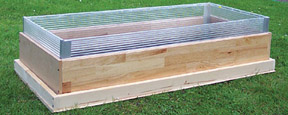
![]() Constructing
a Simple Open-topped Tortoise Enclosure
Constructing
a Simple Open-topped Tortoise Enclosure
'Tortoise-tables' offer many advantages over glass vivariums. Here's how to make your own!
By Sue Brooks

This simple enclosure can be made with minimum technical skills. It is light to move around and easy to keep clean.
The benefits of housing tortoises in open-topped enclosures have been well documented but sometimes the practicalities of actually making one can seem a bit perplexing. Is it going to be light enough to move around once made? Will it be easy to change the substrate? Is it going to be easy to maintain good hygiene? Will it be simple to make? Is it going to look neat in my conservatory or wherever you plan to use it? This design offers a positive response to all of these questions. The technical skills required are limited to the use of an electric drill and a jigsaw,otherwise it is just down to a bit of elbow grease and measuring. No corners were mitered or any other fancy finishing techniques used.
The materials used were:
- 1 pack of laminate flooring (5 pieces)*
- Ĺ sheet of twin walled polycarbonate glazing
- MDF off cuts
- Timber batten
- 4 strong seed trays
- duct tape
* Try not to get the ultra thin type as they would be difficult to screw into. The ones used were 11.3mm thick.
The overall measurement of the enclosure illustrated is 108 cm x 48 cm, but as floorboard sizes may vary and your own requirements will also vary, no precise measurements of the constituent parts will be given.
The most important part is to get your seed trays first and measure them. The ones used here measure 24cm x 38cm but slightly larger or smaller could be used. They will dictate how long and how wide your enclosure needs to be. To this you will need to add the thickness of the side verticals, the thickness of the polycarbonate lining and the timber batten which will hold the main section in place. A look at the separate parts in figure 1 will illustrate this. Donít forget to add a little extra to allow room for fingers when removing trays for cleaning or replacing substrate. When you have your overall base measurements you are ready to begin. First, clip three of your floorboards together and keep them in place using duct tape or similar before cutting to required size using a jigsaw. With the timber batten make an oblong the same size as the base just made and secure it to the base with screws from below. You now have something resembling a tray, which should be firm and stable, enabling you to remove the duct tape. The remaining 2 floorboards can now be used in conjunction with the MDF off cuts to make an oblong inner to fit inside the batten edging. This should then be firmly attached using screws through the timber batten at the front and again at the back. The only job then remaining is to construct a lining using the polycarbonate glazing which can easily be cut with jigsaw or sharp knife. This lining was made about 8cm deeper than the inner, to keep the enclosure light and provide extra security. The outer corners were simply secured with duct tape and it was left unattached to facilitate cleaning. A plastic rim was later attached to the edge of this lining to cover the sharp edges.

The trays can be filled with a soil/sand substrate alone, or preferably planted with edible weeds to be enjoyed by the tortoises. Having 4 separate trays will enable you to vary the habitat a little. In this particular case one of the trays was filled with cobbles to provide a surface for clambering over and also to keep the water dish away from the substrate, which can otherwise turn into a mud bowl. The 4th tray (not seen) was simply filled with folded towels, which provided a popular burrowing area.

Used with a UV-B Active Heat lamp, this enclosure is ideal for any small tortoises requiring indoor accommodation. For ease of maintenance, additional trays can be planted up, ready to exchange with those in use and trays of cobbles which have become soiled, can be put out in heavy rain or simply hosed down and left in the sun to dry.

The total cost of this enclosure was approx £35 (excluding heat lamps and other electrical items)